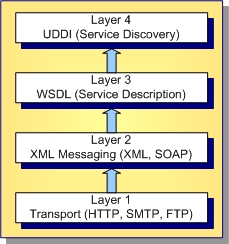|
RAD Studio for Microsoft .NET
|
|
RAD Studio for Microsoft .NET
|
Understanding the Web Services infrastructure requires that you have some exposure to Extensible Markup Language (XML), Simple Object Access Protocol (SOAP), Web Services Description Language (WSDL), and Universal Description, Discovery, and Integration (UDDI). Because the infrastructure already exists, as a developer of XML web services, you can leverage the existing technology by using standard Web protocols such as XML and HTTP.
CodeGear provides an easy way to create, deploy, and use web services without concern for back-end processing so you can focus more on designing your services.
This topic provides the conceptual background to understand how the protocol stack contributes to Web Services functionality:
Web services consist of sets of internet protocols and standards for exchanging data between applications. The Web Services Protocol Stack describes the layering of the set of internet protocols or rules used to design, discover, and implement web services.

The major components or layers of a Web Service Protocol Stack include:
The Transport layer is the first component in the stack and is responsible for moving XML messages between applications. The Transport protocol most commonly used is the standard HTTP protocol. Other commonly used Web protocols are SMTP and FTP.
The messaging layer in the protocol stack is based on an XML model. XML is widely used in Web Services applications and is the foundation for all web services. XML is just one of the standards enabling web services to map between technology domains. You will find many resources on the Web that describe XML messaging. For more information, refer to the World Wide Web Consortium (W3C) site on Messaging listed in the link list below.
The XML Messaging specification is a broadly-defined umbrella under which a number of more specific protocols are defined. SOAP is one of the more popular standards, and is one of the most significant standards in communicating web services over the network. XML provides a means for communicating over the Web using an XML document that both requests and responds to information between two disparate systems. SOAP allows the sender and the receiver of XML documents to support a common data transfer protocol for effective networked communication. You will find many resources on the Web that describe SOAP. For more information, refer to the W3C site for SOAP listed in the link list below.
This layer represents a way of specifying a public interface for a web service. It contains information on available functions, on data types for XML messaging, binding information about the transport protocol, and the location of the specific web service.
Any client application that wants to know about a service, what data it expects to receive, whether or not it delivers any results, and the supported transport, uses WSDL to find that information. When you create a Web Service, it must be described and advertised to its potential customers before it can be used. WSDL provides a common format for describing and publishing that web service information. Typically, WSDL is used with SOAP, and the WSDL specification includes a SOAP binding.
Use CodeGear's Add Web Reference feature to obtain a WSDL document for your web service. The WSDL document, or proxy file, is copied to the client and is used to call the server. This proxy file is named References.*, where the file name extension reflects the language type. For more information about WSDL, refer to the W3C WSDL site listed in the link list below.
This layer represents a way to publish and find web services over the Web. You can think of this layer as the White and Yellow Pages of your phonebook. The White pages of web services provides general information about a specific company, for instance, their business name, description, and address. The Yellow Pages includes the classification of data for the services offered, for instance, industry type and products.
The protocol you use to publish your web services is known as UDDI. The UDDI Business Registry allows anyone to search existing UDDI data and enables you to register your company and its services. With RAD Studio, your data automatically gets published to the registry, or a distributed directory for business and web services.
|
Copyright(C) 2008 CodeGear(TM). All Rights Reserved.
|
|
What do you think about this topic? Send feedback!
|